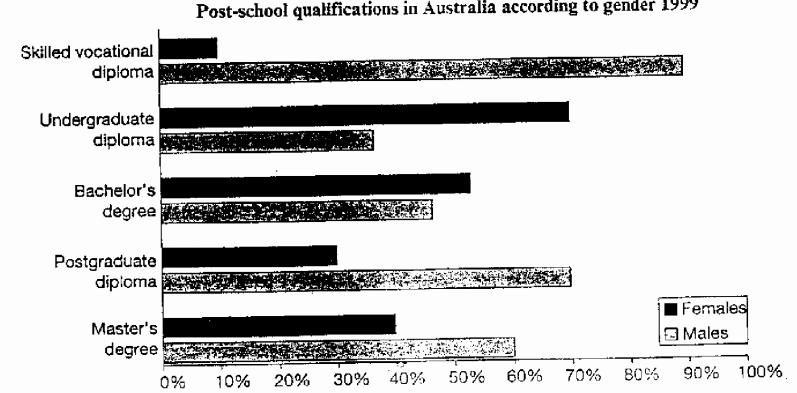The chart below shows the different levels of post-school qualifications in Australia and the proportion of men and women who held them in 1999. Summarise the information by selecting and reporting the main features, and make comparisons where relevant.
The chart compares the percentage of Australian men and women holding five levels of post-school qualifications in 1999. Overall, males were generally inclined to outnumber female counterparts in the majority of the sectors, with the exception of bachelor's degree and undergraduate diploma.
One of the most striking features of the given chart is the apparent gender inequality in skilled vocational diploma with around 90% of male holders, nine times higher than data for females. Likewise, postgraduate diploma and master's degree statistics followed a consistent pattern. The former comprised 30% of female holders, less than a half of men who also achieved the same academic level. Simultaneously, more men secured a master's degree than women with a gap of 20%.
On the contrary, 70% of undergraduate diplomas were occupied by women, doubling corresponding figure for male learners. Additionally, the proportion of female students adopting a bachelor's degree was also higher than that of the opposite gender, with approximately 55% and 45% respectively.
The chart compares the percentage of Australian men and women holding five levels of post-school qualifications in 1999. Overall, males were generally inclined to outnumber female counterparts in the majority of the sectors, with the exception of bachelor's degree and undergraduate diploma.
One of the most striking features of the given chart is the apparent gender inequality in skilled vocational diploma with around 90% of male holders, nine times higher than data for females. Likewise, postgraduate diploma and master's degree statistics followed a consistent pattern. The former comprised 30% of female holders, less than a half of men who also achieved the same academic level. Simultaneously, more men secured a master's degree than women with a gap of 20%.
On the contrary, 70% of undergraduate diplomas were occupied by women, doubling corresponding figure for male learners. Additionally, the proportion of female students adopting a bachelor's degree was also higher than that of the opposite gender, with approximately 55% and 45% respectively.

f3c0ee3e9af99630debc.jpg
